Costa Rica has become one of the first safe American destinations in 2021, and that has resulted in a rapid recovery in tourism after long months of the pandemic. This peaceful corner of Central America, where respect for nature and outdoor adventures are its hallmarks, is once again opening up to the world with a multitude of attractions.
There are many things that can be done in Costa Rica: from getting on a surfboard —it is one of the most sought-after destinations for practicing this sport— to relaxing on a yoga mat; going down to caves full of bats, climbing volcanic peaks, walking, pedaling or sliding down zip lines… Endless adventures that even involve discovering the charms of a stopover in its unnoticed capital, San José.
Most tourists come to Costa Rica to visit the central volcanoes (Poás or Arenal, for example) or national parks that never disappoint, such as Manuel Antonio (the closest to the capital), Tortuguero, Corcovado (on the Osa peninsula) or to the fantastic Monteverde Cloud Forest.
It is almost obligatory to also know some of the surf paradises along the Pacific coast or there are even those who are encouraged to explore the other end of the country: the Caribbean coast. Next, we launch some proposals, several of them outside the most common routes, to enjoy this prodigy of nature as it deserves. Pure Life.

The Costa Rican Caribbean with a Jamaican flavor
The southern coast of the Caribbean is the heart and soul of Costa Rica’s Afro-Caribbean community. In the mid-19th century, many Jamaicans came to build the railroad and then stayed to work for the American banana company United Fruit. Also in this area, but further inland, still live some of the most important indigenous groups in the country: cultures that have been preserved intact despite centuries of incursions, first by the Spanish, then the banana industry and today tourism. They live, above all, in the areas of Cocles, Talamanca and Bribri.
But this is not an isolated bubble: since the 1980s, the south coast has welcomed surfers, backpackers and families on vacation, in many cases taking root and adding Italian, German and North American flavors to this mosaic. cultural. For the visitor, it is always a different and very rewarding experience, with beautiful beaches from which to enjoy long days of sun and sand.
Cahuita, near the border with Panama and with a relaxed Caribbean atmosphere, or Puerto Limón, the most important pier in the country and where Christopher Columbus landed while exploring the New World, are the best known and most visited places, but there is still much to discover for those who have an interest and desire for adventure.
For example, Selva Bananito, near Puerto Limón, one of the most isolated and delicious ecotourism offers in the country, with wildlife observation, exquisite food and comfortable Caribbean-style palafitos (cabins over the water) made of recycled wood. It is located at the foot of a hill, on the edge of La Amistad International Park – the largest terrestrial protected area in Costa Rica and one of the regions with the greatest biodiversity of species and ecosystems – and has been dedicated to sustainable tourism for three decades. betting on solar energy and biodegradable products.
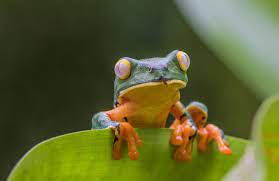
Boca Tapada, an unprecedented destination among plantations
If we head north through the interior, before reaching the border with Nicaragua, the area known as Boca Tapada breaks through. This is a journey through pineapple plantations to discover the virgin forest of the Maquenque Mixed National Wildlife Refuge. It is a not very touristy destination, ideal for adventurous spirits. The stony roads and lack of signage may force some unwanted detours, but the payoff is a great eco-show.
This wetland is home to endangered animals such as the guayacamo or green macaw, vulnerable species such as the manatee and other relevant species such as the jaguar and gaspar fish. In total, a total of 139 species of mammals, 135 of reptiles, 80 of amphibians and 424 of birds are cataloged. Passing through fields of pineapples and packing plants, the traveler passes peasants and at the end of the road he can enjoy a piece of lush tropical jungle, full of exotic birds and the croaking of frogs. The accommodations in the area offer excursions to the Mixed Maquenque National Wildlife Refuge.
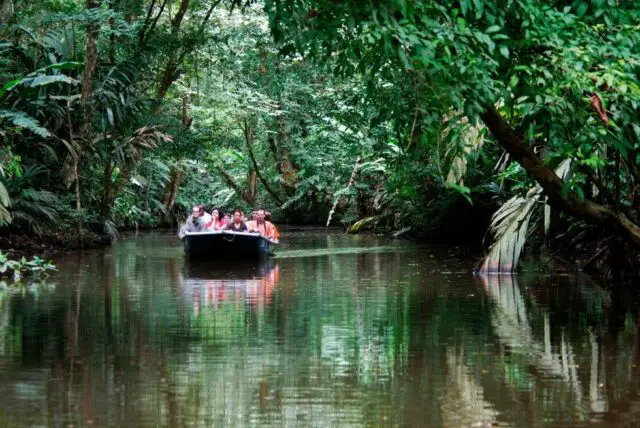
Turtle watching in Parismina
Without leaving the north coast that bathes the Caribbean, halfway between the towns of Tortuguero and Puerto Limón, there is Parismina, a less crowded alternative than the neighboring Tortuguero National Park, and which is gaining more and more followers among those who travel the country.
This long stretch of sand between the mangroves and the sea has a skeletal tourist infrastructure and not much action other than turtle conservation and kayaking the canals. Something that allows you to imagine what the Caribbean coast of Costa Rica was like before the arrival of tourism. The best way to do this is to disembark in this sleepy fishing village sandwiched between the Tortuguero canals and the sea. Without zip lines or resorts, it is the typical place where you can find old people playing dominoes on the porches and children splashing in the puddles.
For the intrepid willing to undertake the journey, Parismina is also a magnificent place to see turtles and help their conservation, and without the crowds of Tortuguero. Although fewer and fewer species spawn here, leatherback turtles can be seen between late February and early October; and green, between February and September. In addition, there is a turtle hatchery where volunteers can help guard the eggs. Sport fishing is the other traditional claim for tourism in the area.
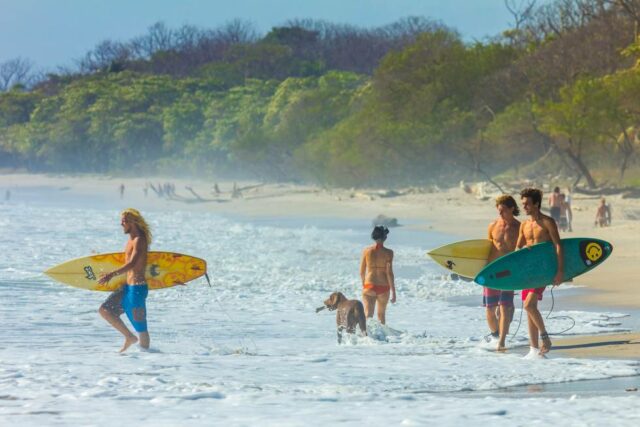
Malpaís and Santa Teresa, surfer’s paradise
Taking a leap to the other Costa Rican coast, that of the Pacific, in the Nicoya peninsula, the largest in the country, you can combine adventure in tropical nature with the charms of its boutique hotels, exquisite restaurants or spas to care for and nurture body and soul. And if you are looking for more tranquility than strong emotions, here the days can simply pass swayed by the sea breeze.
At the southern end of this peninsula overlooking the ocean are two of the favorite destinations for surfers: Malpaís and Santa Teresa. Until relatively recently these two neighboring towns were considered an almost secret corner and, although they are no longer so, Santa Teresa is still a wonderful surf town, with many places to eat and some nightlife. Throughout the area runs a rugged coastal road that heads south from Santa Teresa, passes through Carmen beach and ends in the fishing village of Malpaís.
The long and spectacular Santa Teresa beach is famous for its fast and powerful break. And when the tide goes out it looks spectacular. Surfing is the main attraction of the place. Most travelers don’t do anything else except stretching their muscles and a little yoga. But there are more options to take advantage of the environment: horseback riding, fishing excursions or zip line circuits.
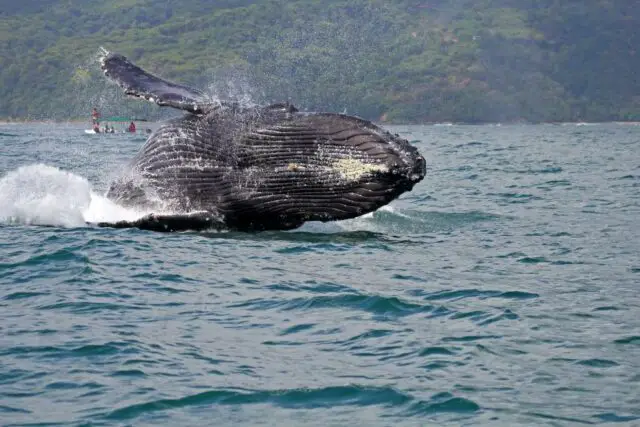
Costa Ballena: waves, whales and good food
The central Pacific coast is the closest outlet to the sea to San José. The inhabitants of the capital come here to spend the weekend and many international tourists. South of Quepos, the gateway to the Manuel Antonio National Park and where the well-trodden Central Pacific tourist route takes its last blows, the area is transformed and evokes the Costa Rica of years ago, with empty beaches, roadside cevicherías … and a incomparable surf. Known as Costa Ballena, the beautiful stretch between Dominical and Ojochal (barely 35 kilometers by road in which beaches and cliffs alternate) stands out for three things: surfing (Dominical), whale watching (Uvita) and cooking (Ochojal ).
As far back as memory goes, Dominical was a small town that attracted a diverse collection of surfers, backpackers and friendly friends of the good life, a place where the traveler could wander through the dusty streets with the surfboard under his arm after a day of intense waves.
In 2015 the first real road came to town and a growing population of expats and Americans began to settle, bringing in some more sophisticated businesses. Now it is a popular destination, but when the rains come, Costa Ballena empties and returns to being the old and placid Costa Rica of always. surf at almost all hours. To the north, it leads to Playa Hermosa, which lives up to its name: it is wide
Dominical owes its fame to its cost and its spooky breakers. It is a good corner to get started in this sport, although the nearby Dominicalito beach is not the gentlest for beginners either. Neighboring Uvita retains its slow pace of life during the low season, but has become a popular destination thanks to its main attraction: Marino Ballena National Park, famous for its humpback whale migrations and its unspoiled beaches with almost no people.
There are also nice waterfalls nearby. Two important tourist events for the country take place in Uvita: the whale and dolphin festival, which celebrates the arrival of humpback whales, and the largest hippie gathering in Costa Rica, the Envision Festival.
Ojochal, on the other hand, is the culinary epicenter of the area with influences from Mediterranean to Indonesian, with a multicultural population of foreign residents and a completely different environment from Sunday surfers.
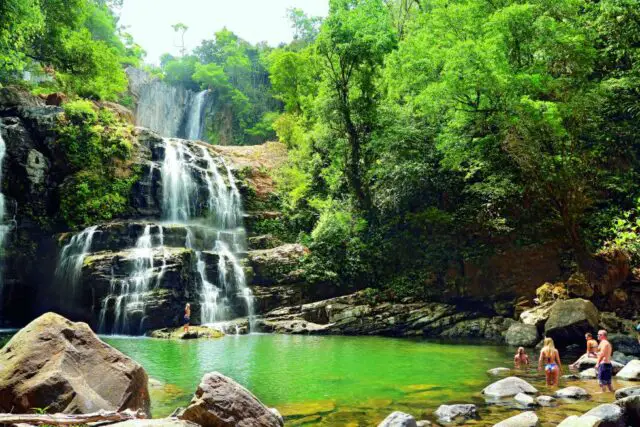
Sarapiquí and the Poza Azul waterfall
Travelers who fix their gaze on the north of the country mainly do so to enjoy the Arenal volcano (1,670 meters), its national park and its many lodges in the middle of nature, with thermal spas in the middle of the lava, picturesque walks and unique experiences to the fresh air. They are one of the strong points of any tour of Costa Rica. But here, in the northern reaches, there are other less visited areas.
Those who venture through secondary roads will discover the most rural side of the country and places such as the Caño Negro National Wildlife Refuge, with marshes and lagoons reminiscent of famous wetlands such as the Florida Everglades or the Mekong Delta (in reduced version). Or the Sarapiquí Valley, an expanse of plains full of farms that in the past were part of the large farms of the United Fruit Company banana company, with US capital.
The waters of the Sarapiquí River are not as rough as those of the nearby Pacuare River, lush jungle that borders the river offers the opportunity to see fauna from the rafts that descend through this generous flow of water in search of adventure.
La Virgen, an old town from the golden age of the banana trade, is hidden in the dense wild vegetation of the Sarapiquí. For more than a decade, it was the main kayaking and rafting destination in Costa Rica, but an earthquake changed the course of the river and dragged its tourist economy. Today there are only a few establishments open, but more and more rafting fans are returning independently to get carried away by the rapids or to look for a transparent pool where they can enjoy a relaxing bath, such as the Poza Azul waterfall, which for many is the best waterfall across the country.
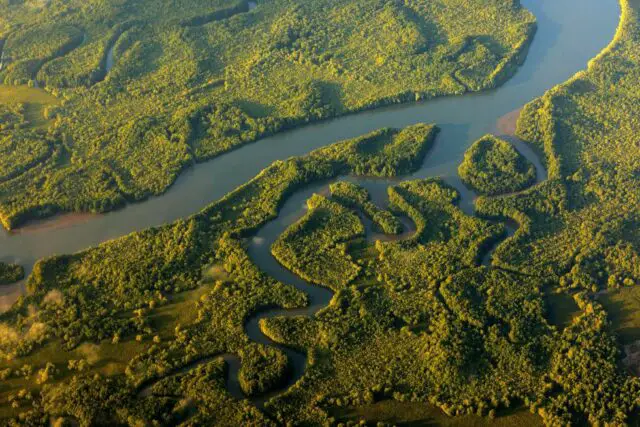
The Osa peninsula: the last virgin corners
Despite its relatively small size, the Osa Peninsula, on the southwest Pacific coast, is home to a large number of tropical habitats: rainforests, coastal wetlands, and mountain forests. It also includes some of the least explored and urbanized corners of Costa Rica.
For example, in the La Amistad international park, where there are vast areas intact where representatives of the country’s most relevant indigenous cultures (Bribri, Cabécar, Boruca and Ngöbe) live in reserves. It is also home to birds such as quetzals or macaws, and animals such as sloth monkeys and coatis. There are secluded beaches, surf, and plenty of wild territory for intrepid travelers looking for something wild.
A three-toed sloth and its young, hanging from the top of a tree in Costa Rica, where this animal is a national symbol.
This is also where the main protected area in the country is: the Corcovado National Park. It is the last stretch of the original tropical forest that is conserved in the Central American Pacific coast. Bastion of biodiversity, it is home to half of Costa Rica’s species. There are three main routes open to the public for those who want to walk the park and many other trails that should be accompanied by a guide.
On the peninsula there is also Drake Bay, a small bay that is thought to have been discovered by the English privateer Francis Drake in the 16th century. It is one of the most remote destinations in the country, a true lost world, embraced by Corcovado Park.
In the rainforest canopy, howler monkeys greet the sun with their captivating cry, while pairs of macaws flying through the treetops fill the air with their cacophonous chants. In the bay, pods of dolphins plow through the turquoise waters near the beautiful Caño Island Reserve, a tiny 300-hectare territory 20 kilometers from Drake Bay.
Drake remains isolated from the rest of the country, and therein lies its charm. Everything revolves around the humble town of Agujitas (1,000 inhabitants), the area’s transportation hub, attracting a growing number of backpackers and nature lovers. There are cheap accommodation and a wide range of diving and excursions to observe the rich fauna.
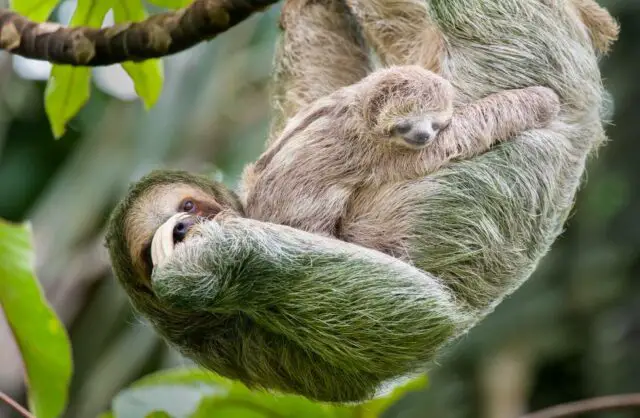
Isla del Coco, the diving paradise
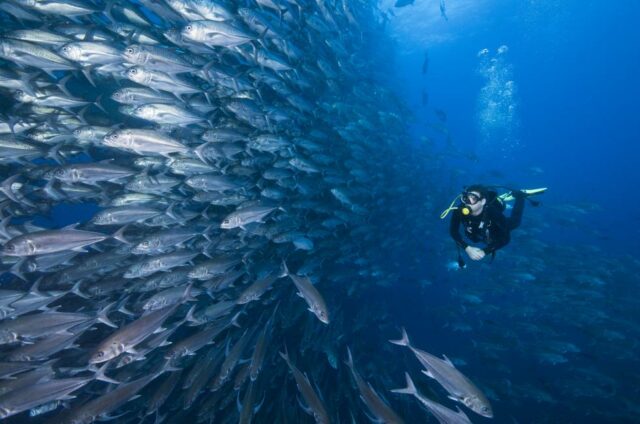
It is the most remote destination in Costa Rica, an island half a thousand kilometers southwest of the mainland. Although it is no more than a green speck in the middle of the infinite Pacific, Cocos Island is in the imagination of all adventurers: jagged mountains and stories of treasures, a virgin and isolated ecosystem rich in fauna and unbeatable conditions for diving.
This is the tropical island that the helicopter flies over in the opening shot of Jurassic Park, directed by Steven Spielberg in 1993 and based on the eponymous book by Michael Crichton. It is also believed that Robert Louis Stevenson’s Treasure Island was precisely Coco. But the most beautiful thing is not the island, but the sea that surrounds it: ranked by the PADI (Professional Association of Diving Instructors) among the ten best diving destinations in the world, many pelagic species live in the waters of Coco Island. (those that live in medium waters or near the surface), including one of the largest schools of hammerhead sharks known on the planet.
Before the divers, there were pirates around here, many pirates, who are rumored to have hidden countless treasures. The most famous was the legendary treasure of Lima, a millionaire booty that a British captain hid in 1820. More than 400 expeditions were organized to find this booty of silver and gold bars and an image of the Virgin made of solid gold. The riches are still under its waters, but this time in the form of a huge biological variety. There are 235 species of plants identified; 362 Insects; 85 birds; 57 of crustaceans; 118 of mollusks, and more than 200 of fish and 18 of corals.
Punta Leona and Playa Herradura, secret corners
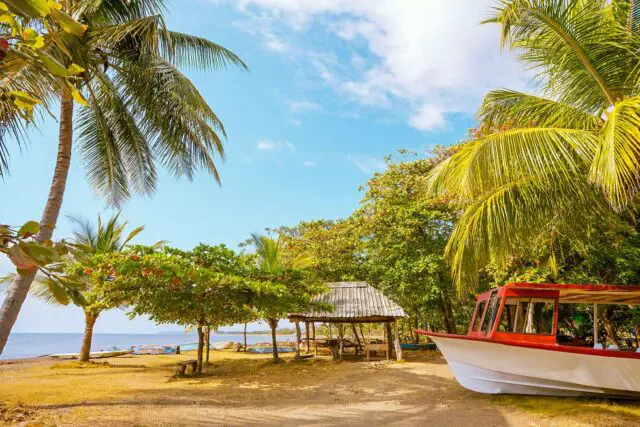
Punta Leona is a closely guarded secret. Beyond a couple of easy-to-overlook accesses and long, winding entrance roads, its serene beaches (Mantas and Blanca) are the first that the traveler can visit when descending from San José along the central Pacific coast, to just an hour’s drive from the capital.
In Punta Leona there is a huge resort, with a country club, a couple of restaurants and access to the beach: the Punta Leona Hotel & Club. Banca Beach is majestic, at low tide it is easy to cross the slabs at the other end of the point – at high tide they are submerged but it is not advisable to swim across them – and you can go and return to Playa Blanca: the reward for effort it is an immense cove with white sand, calm waters like a jacuzzi and sloping coconut trees. It is almost a paradise, frequented mostly by families, especially on holidays.
Nearby is Herradura Beach, which a couple of decades ago was nothing more than a strip of dark sand, with palm trees and local fishermen. But in the 1990s it rose to fame as the setting for the film 1492: Conquest of Paradise, by Ridley Scott.
The result was rapid development and construction of the Los Sueños marina, one of the most luxurious in the country. Today Herradura represents the possible future for the central Pacific coast, with sophisticated apartments and hotels, but the southern half of the beach is still a typically local stretch where Ticos go to eat and have fun, with informal restaurants where you eat with your feet. on the sand.
A few days in San José, a capital off the beaten path
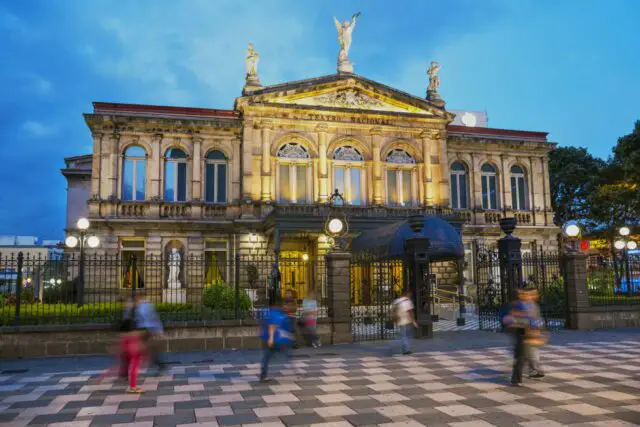
The capital of Costa Rica is not exactly one of the most charming cities on the continent, at least when it comes to monuments, museums or neighborhoods with colonial airs. But in return, San José is the true cultural heart of the country: here are university students, intellectuals, artists and politicians, and also nightlife and even unexpected street art.
Travelers always stay in Chepe for a short time, as it is affectionately known by its neighbors, but the city has its charms and, above all, it is an inevitable stop, so it is worth spending a few days to enjoy it as it deserves.
The essential tourist circuit passes through the Pre-Columbian Gold Museum, the Jade Museum, the Central Market or the jewel of the city: the National Theater, the most revered building, from the late 19th century, like a candy box in the heart of the city. town. A curious visit is also the Museum of Costa Rican Art, installed in a Spanish-style building that was the terminal of the San José airport until 1955, in the La Sabana neighborhood.
To stroll through the most fashionable districts, you have to go to Escalante, the gastronomic epicenter of the city, especially around 33rd Street, or take a walk through the Amón neighborhood, a pleasant and historic neighborhood with mansions of coffee growers from late 19th and early 20th century. In recent years many of these historic buildings have been transformed into hotels, restaurants and offices. There is everything from Art Deco style homes to colorful tropical Victorian buildings.
But the wealthiest Ticos live on the outskirts, in neighborhoods like Escazú and Santa Ana, with many restaurants and accommodations ranging from refined boutique hotels to authentic resorts in the middle of the city.
If we are only going to take San José as a stopover on the trip to the beaches or national parks, a good idea is to enjoy a mini-vacation in hotels that are true oases. Places like the Real InterContinental San José, in Escazú, is an island in the middle of the city, with lush gardens, swimming pools, a spa, shops and some of the best restaurants.

